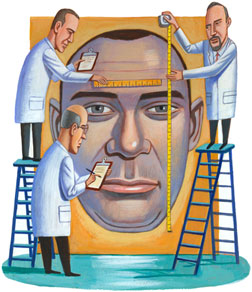Can you tell if a man is dangerous by the shape of his mug?

Posted Wednesday, Oct. 14, 2009, at 10:36 AM ET
On Nov. 27, 2008, Indian police interrogators came face to face with the only gunman captured alive in last year's bloody Mumbai terror attacks. They were surprised by what they saw. Ajmal Kasab, who had murdered dozens in the city's main railway station, stood barely 5 feet tall, with bright eyes and apple cheeks. His boyish looks earned him a nickname among Indians—"the baby-faced killer"—and further spooked a rattled public. "Who or what is he? Dangerous fanatic or exploited innocent?" wondered a horrified columnist in the Times of India. No one, it seems, had expected the face of terror to look so sweet.
The notion that a man's mug reveals his character is an age-old bias. Since Aristotle, people have thought it possible to infer personality traits from the face and body, an art known as physiognomy. The practice grew popular in the years after the American Revolution, when a Swiss enthusiast published a series of illustrated pocket guides to help readers interpret faces on the go. Soon, it was plain to everyone that a man's greatness was prefigured in his face. (George Washington's big schnoz, for example, signaled strength and foresight.) Over the next 150 years, a gang of enterprising physiognomists set about using the new "science" to identify society's bad apples, too.

No comments:
Post a Comment